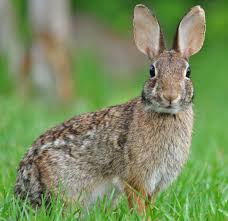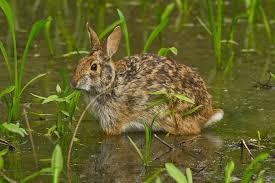It ain’t easy being a Texas rabbit. There’s floods, droughts, freezes, wildfires, scorching heat, tornados and only two seasons (summer & everything else). Add to that: ten ecoregions, all with their own terrain, climate, water issues and plant life. And, with an average lifespan of only 15 months, rabbits are nature’s most popular meal. They’re eaten by just about everything quick enough to catch them. Additionally, rabbits are under perpetual siege from gardeners and ranchers fighting to protect their crops, vegetables and flowers. When a young Texan gets a rifle, rabbit hunting is often their first outing. Rabbit survival is so difficult in Texas it takes five different species to populate the state! Let’s meet these Five Amigos.

Our first amigo, the eastern cottontail,is the most prolific. If you ever spy rabbits enjoying your lawn in the early evening or morning hours, chances are they’re eastern cottontails. Marked by that distinctive “cotton ball” tail for which it’s named, this rabbit is found all over Canada and South America too. In the U.S., the eastern cottontail ranges from the east coast to the Great Plains. Cottontails have those large, liquid, brown eyes high up on the sides of their head designed for 360-degree surveillance. They hang out in open grassy areas, surrounded by abundant greenery and dense shrubs/edges for cover and escape. You seldom find a cottontail in deep woods.
Cottontails are known for their endlessly twitching noses—they do it between 20 and 120 times a minute! They’re analyzing the aromas that define their environment, exposing some of the hundred million sensing receptors in their nose. Long, cupped ears are also continuously moving, locating and amplifying surrounding noises. These are necessary behaviors if you’re on everyone’s menu. A cottontail’s first defense is to freeze in place, hoping its camouflage will save it. If that doesn’t work, they dash! Since their range is relatively small, most escapes are planned in advance, taking advantage of shrubs, brambles or small holes in fences. They can turn on a dime while running a random zig-zag pattern to confuse their pursuers—top speed 18 mph. They also bite and kick (hence the term “rabbit punch”).

Eastern cottontails are active all year round. Generally, they don’t use burrows but hide in a shallow, scratched-out depression in a clump of grass or under brush. They’re continually munching—a good thing to keep their growing upper teeth worn to a useable length. Like all rabbits, they re-cycle their own poop by producing two types of fecal pellets. The first—highly nutritious, gel-like fermented droppings—is eaten for extra energy and enhanced digestion (despite how gross this sounds, it’s fairly common in some herbivores). The second—round brown pellets—is true feces, left behind as treats for the family dog!

In matters of the heart, cottontails have one of the world’s most unusual courtship rituals. The male chases the female until she stops, turns and stands up on her hind legs and punches his ears and face. “Take that, you cad!” They then sit facing each other. The male moves closer to the female and then leaps high in the air and flips around 180 degrees. As he’s doing this, she runs under him and also turns 180 degrees—finding themselves facing each other once more. Then the female does the jump-and-spin while he does the run-and-spin. They alternate this way until they succumb to a fit of fever pitched, bodice-ripping sex! This is where “Mad as a March hare” comes from.

As we know, rabbits take love-making to a whole new level. With such a short life-expectancy, they’ve got to keep crankin’ out babies to keep up with demand. In most regions of the country there are distinct breeding seasons. In Texas, eastern cottontails breed all year long. The “kits” are born with a very fine coat of hair and are blind. Eyes open in 4-7 weeks, they’re out and about within 12-16 days and are weaned and independent by 4-5 weeks. Litters disperse at about 7 weeks. Females don’t stay with the babies, except to nurse, usually twice a day. Half of all kits never make it out of their nests!

Our second amigo, the Desert cottontail,likes wide open spaces. They live throughout the Plains states and can be found up to 6,500 feet of elevation. Here, that means you’ll find them in west Texas. Like all cottontails, they’re loners but will tolerate neighbors without much interaction, unless, of course, they’re horny. Given the geography, the desert cottontail’s fur is lighter colored, its ears slightly larger (with blood vessels just below the skin for heat dissipation) and is active at night when temperatures are cooler. Diet is standard desert fare, to include leaves and peas of mesquite, juicy prickly pear pads, bark, fallen fruits and twigs of shrubs. Desert cottontails seldom drink, getting their water from dew or the plants they eat.
But life’s tough in the badlands. Habitat loss due to land clearing and cattle grazing impact the desert cottontail population, as do natural wildfires and flash floods. Desert cottontails also compete with black-tailed jack rabbits for the same diet and habitat, and because jack rabbits consume much more food, dry season pickin’s can be sparse for the smaller cottontail. Believe it or not, most jack rabbit face-offs are won by the more aggressive desert cottontail. The ears go back, the chin juts forward, thumping begins, growls are emitted, and a war is on. For the skittish jack rabbit, it’s easier to just bound off into the sunset. Silly wabbit!

So our third amigo is the black-tailed jack rabbit. Black-tails have ears and tail tipped with black fur (duh!).

They have long slender front legs and large hind feet that can be 5 inches in length. They’re big and impressive. There’s five other species of jack rabbits, all found in central and western North America. Some people think they’re nothing but big rodents, but not so. While they do share a common rodent ancestor, jack rabbits aren’t even true rabbits—they’re hares. The much more northerly Arctic hare and Alaskan hare are larger than the jack rabbit members of the hare genus. What makes a hare? Hares are larger than rabbits, with taller hind legs and longer ears. Baby jack rabbits, called leverets, are born fully furred with eyes open—otherwise, they’re rabbits in every other way.
Jack rabbits are speedy animals capable of reaching 40 mph and they can leap 10 feet with ease. When at a moderate run, every four to five leaps are exceptionally high to see their surroundings. They will leap over objects rather than run around them. They use these leaps, combined with that zig-zag running style, to evade predators. The jack rabbit runs with its ears flat and tail between its haunches. Jack rabbits were originally named for their ears. Some people referred to them as “jackass rabbits,” later shortened to jack rabbit.

Next, to meet our fourth amigo, we shift our attention to the Gulf Coast and the south-central U.S. to find the swamp rabbit. It’s well-named because it hangs out in swampy lowlands, floodplains, cypress swamps and along edges of rivers and creeks. It’s also the largest of the cottontail genus but with smaller, rounder ears and coarser fur with a more yellow cast. Its dense fur is thick enough to waterproof its skin. Swamp rabbits are adept swimmers—when a predator approaches, they escape to the water, diving under roots or overhangs. Contrary to our other Texas rabbits, male swamp rabbits are larger and heavier than females. Babies are born helpless but furry (with eyes closed).
Uncharacteristically, the home range of our last amigo is immense. It’s found, in addition to Texas, almost everywhere, except Australia. The species originated in the Old World—Germany to be specific—but, even if you allow for obscure religious assimilation of pagan rites and ceremonies, the taxonomy on this one really comes out of left field. I mean, who would believe an anthropomorphic, egg-laying rabbit who sneaks into homes the night before an important Christian holiday to deliver baskets full of colored eggs, toys and chocolate to children? That’s right, to support a cherished childhood experience, I hereby attest to the existence of the Easter Bunny!

You have to go way back for this one to make any sense. Many pagan cultures held spring festivals to celebrate the renewal of life. One of these festivals honored Eostre (or Eastre), the goddess of dawn, an admired deity close to the hearts of Old-World Europeans. Eostre was closely linked to the hare and the egg, both of which were symbols of fertility. Well, you couldn’t find a better example of fertility than a rabbit! Despite the questionable taxonomy of this particular rabbit, one piece of good news is certain: You won’t ever find the Easter Bunny on anyone’s endangered species list.
By Larry Gfeller


